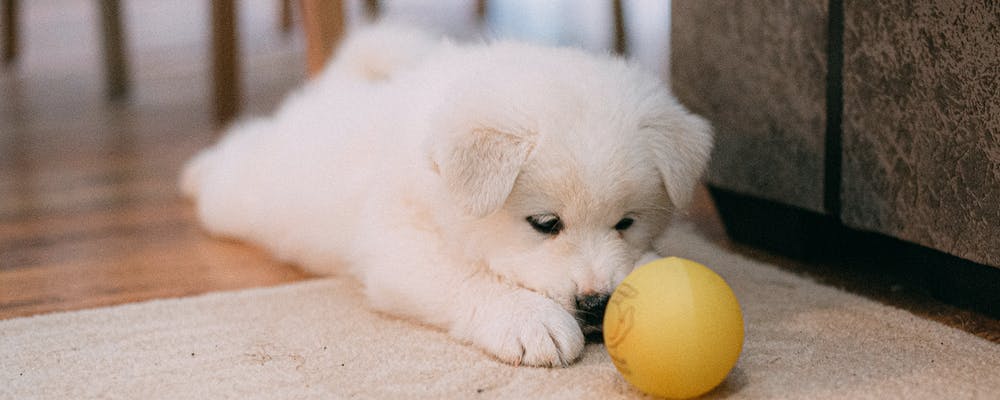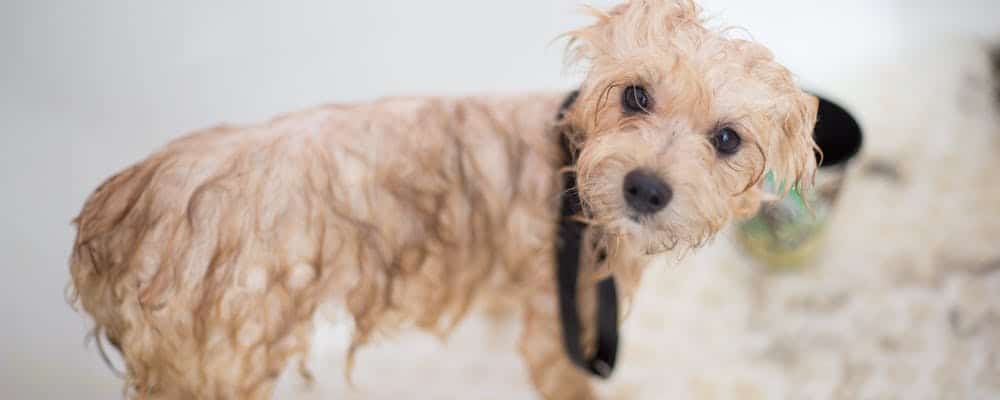How to Navigate the First 48 Hours with Your New Pup
Getting a new puppy is an extremely exciting and joyful occasion for your family. However, the transition to a new environment and family can be confusing and stressful for many pups. Leaving the comfort and security of their mother causes anxiety and uncertainty in many pups. It is critical to have a plan in place before you bring your pup home so they can immediately begin acclimating to their new environment with as little stress as possible. Your puppy is not the only one who will be heading into a new environment. New dogs bring all kinds of changes to your routine, sleep schedule, and shopping list.
In this article we dive into what to expect in the first 48 hours with a new dog and what you need to do in order to make sure your pup loves their new home. We also cover how to begin training your pup and structuring their routine to make your pet adoption as smooth as possible.
Step 1: Find a Veterinarian
Before you pick up your dog you should have at least made contact with a veterinarian. A vet will help you select an appropriate diet for you pup based on their breed and age as well as provide recommendations for any other supplies you may need the first few days with your puppy. Between shopping for food, beds, potty pads, crates, and other accessories your vet will provide essential information about what vaccines or deworming procedures your puppy needs to make sure they stay healthy. Although you do not need to take your pup to see the vet in the first 48 hours you should schedule an introductory appointment within 1-2 weeks so make sure your puppy has a clean bill of health. If for some reason your puppy gets sick or has medical issues like vomiting or diarrhea in their first few days it is a huge help to already be established with a vet so you are not left scrambling. When you bring your dog to the vet make sure to discuss a socialization strategy with your vet. This ensures your pup stays and develops a healthy relationship with other pets as they get older.
Step 2: Go to the Pet Store
Before you pick up your pup you should go to the pet store to make sure you have all the equipment, food, and accessories to properly care for your dog as soon as you get them (or place a big order online). The day of adoption is an extremely stressful and tiring day for any dog. Bringing your dog into a pet store the first day you are together is asking for a disaster to happen in the pet store. In addition to shopping for basic necessities for your dog like food and a bed you should make sure to pick out essential grooming supplies, shampoos, treats, and toys to make them feel welcome as soon as they get home. Do not procrastinate buying grooming supplies for your dog. Getting your puppy used to a normal grooming routine is extremely important. If you do not create a routine for regular bathing, paw trimming, and coat care your dog will end up refusing to take baths or be groomed. Below we have added our top lists of essential puppy supplies new owners need to get before adopting a dog.
- Washable pee pads for potty training
- Calming puppy beds
- Dog harnesses
- Puppy food
- Puppy toys
- Natural puppy shampoos
- Puppy nail files
- Dog hair clippers
Step 3: Puppy Proof the Car
Although it is normal for many adult dogs to roam freely in the back seat, young puppies need to be treated like babies when riding in the car. This means securing them in a dog car seat, kennel or crate to make sure they are protected when driving in the car. If you hold a puppy on your lap they could be seriously injured if you stop suddenly or in a car accident.
Young puppies are also not potty trained. If you are content to hold your pup on your lap there is a good chance they will go to the bathroom whenever they feel like it! The best strategy is to make sure you keep pee pads, disinfectant wipes, potty bags, paper towels, and hand sanitizer in the car at all times. This ensures you are prepared to handle any potential accidents your puppy has while transporting them home. Depending on the length of your drive and the age of your puppy, car rides can be stressful for many young dogs. Giving your dog a treat or small toy to play with is a great way to keep them relaxed and content in the car.
Take Frequent Breaks on the Trip Home
Many new pet owners do hundreds of hours of research to figure out which type of puppy is a perfect fit for their family and household, while others simply pick out a cute pup at a local animal shelter. Many puppies get car sick easily, especially if they have not spent much time in the car. If you are traveling over an hour to go pick up your puppy you should plan on taking multiple breaks to let your puppy stretch their legs and go to the bathroom. Additionally, if your pup went to the bathroom in their crate you will need to clean it up so they are not riding in their own waste. Although puppies are not very fast it is important to make sure you attach a leash or harness to your dog before letting them out of the car.
Step 4: Puppy Proof Your Home
Bringing your dog home before puppy proofing their living quarters is one of the most common mistakes new puppy parents make in the first 48 hours. While small puppies are most likely incapable of doing much damage they will go to the bathroom pretty much anywhere. It’s important to set a precedent of what is off limits in the household. This may include going in the kitchen or in a particular room where they could injure themselves. Plus puppies grow very fast. In a few short weeks your puppy may be capable of scratching up your floor or chewing up pillows. Below we have listed a few recommendations for getting your puppy acclimated to their new environment to keep them safe, happy, and healthy.
- Crate Training: Although it is inhumane to leave any dog in a crate for extremely long periods of time crate training is part life. It is a good idea to get your dog used to crate training as soon as possible. The longer you wait to start crate training the more resistant your dog will be in the long run. A great way to start crate training is to put your pup in the crate at night and keep the crate in your room where they can see you. This helps build a sense of comfort and trust the first few weeks you are living together,
- Play pens: Play pens and kennel flooring are both great options to protect your floor and furniture if your pup is aggressive with your furniture and belongings. Play pens are a great way to make sure your dog gets the exercise they need without tearing through the whole house. This is a great option if you are going through the “potty training” phase with your pup.
- Kennel flooring: Kennel flooring is a great option for play pens when living with a new puppy or fully grown dog. Kennel flooring is a great way to keep floors from being scratched up or used as a potty. Kennel flooring is a cheap, lightweight, and easy to clean option to keep the floor pristine while still giving your dog plenty of space to move around without feeling cramped.
- Chew Toys for Teething: Whether it is your favorite pair of shoes, couch cushions, or other home accessories all experienced pet parents have dealt with teething puppies tearing through their possessions at some point in time. Having chew toys available for your puppy is a great way to help them through teething while hopefully sparing some of your possessions. Most puppies start teething around 3-4 weeks so it is important to have chew toys available for them as soon as you bring them home.
- Brushing & Grooming: The breed of dog you adopt will impact how much hair they shed. Huskies, retrievers, and German Shepherd all shed a lot of hair. If you adopt a dog that is mixed with any of these breeds you should expect a fair amount of shedding. A regular bathing and grooming routine is critical not only to keep the hair out of your house but also to to keep their coat healthy and clean. Make sure to start regularly brushing and washing your dog’s coat as a puppy so they learn to tolerate grooming without fussing too much at an early age.
- Create a schedule: This applies to eating, sleeping, exercise, play time, and everything in between. The best way to help your pet acclimate to a different home is to build a routine they can get comfortable with. This means having a set feeding schedule and exercise program. This is a great way to not only train your pup but set expectations and ease their potential anxiety moving into a new home. In the first 48 hours your pup’s life will have completely changed. The stability of a schedule is proven to make them more friendly and accepting of their new family.
- Let them sleep in your room: New puppies are just like babies. They will most likely wake up in the middle of the night and cry. Although you do not have to let your dog sleep in your room forever, letting them sleep there the first few nights is a great way to build trust and ease their nerves.
Step 6: Be Prepared for Potential Health Issues
In an ideal world your puppy is 100% healthy and never gets sick. However, transitioning your pup’s diet or moving them to a new environment could cause adverse health effects in the short term. If you completely change your dog’s diet overnight there is a good chance the sudden change could cause vomiting or diarrhea for a few days. If possible keep your puppy on the diet they were on before you adopted them and slowly transition them to the new diet over 1-2 weeks. Depending on where your puppy was born before you adopted them it is possible they could have worms or fleas. This is very common for dogs born on farms, or if the mother was frequently outside during the third trimester. It is important to schedule an appointment with your vet within 2 weeks of adopting your pup. Your vet will be able to tell for certain if there are any health issues that need to be addressed with your puppy.
Step 7: Potty Training Your New Dog
It is never too early to start potty training your puppy. The smell of dog pee and poop in your house is not something you or your pup should get used to. Before you bring your pup home you should be fully equipped with pee pads and disinfectant wipes to clean up any messes. Puppies typically have small bladders so it is recommended you take them outside to go to the bathroom 9-10 times a day for the first few weeks. Everytime your dog correctly goes to the bathroom outside, reward them with a treat to build a positive association.
Paper pads and a regular potty schedule are a great way to get your puppy potty trained in the house. When your puppy uses the potty pad you can reward them to build pattern recognition. Crate training is also a great way to potty train your pup. They will not go to the bathroom in their crate unless they are incapable of holding it. Treats are also a great way to incentivize your dog to go to the bathroom outside.
Indicators Your Pup Needs to Use the Potty
If your dog begins whining, crying, or scratching at the wall that is likely an indicator that they need to go to the bathroom. Squatting or sniffing the carpet is also a common sign that your dog is about to go to the bathroom. You can also put a bell by the door they can ring when they want to go outside. If your puppy does go to the bathroom in the house, pick up the poop or show them the wet spot. Then take your pup outside. This will build an association that they need to go to the bathroom outside.
Step 8: Keep Your Puppy at Home
Bringing your pup to their new home is a big, stressful step for most puppies. It is important to keep your dog away from potentially stressful stimuli while they are getting used to life in their new home. This includes taking them to the pet store, dog parks, or crowded areas where they could have interactions with other pets. If you already have pets at your house, discuss the best way to begin socializing your pup with your vet to ensure their safety. Once your puppy begins to feel at home you can start bringing friends over so they can get interaction with other humans. Begin introducing your pup to new pets slowly. It is important to make sure you are present whenever your puppy has a new interaction with another dog. Larger dogs can be aggressive with small dogs so it is ideal that they initially interact with dogs that are a similar age and size.
How to Introduce Your Dog to Other Pets
If you have other pets your puppy will need to get used to them quickly. It is highly recommended that you are in the room at all times when your new puppy and existing pets are interacting with each other. Many new pet parents will keep their new puppy in a play pen so larger animals do not injure them by accident. Some dogs will be aggressive towards new puppies because they get jealous. To make sure this does not happen make sure to spend some time alone with your existing pets. You can take them on a walk or play with them one on one. In time your dogs will get used to each and become friends. However, you need to make sure you are watchful over your new puppy until they are big enough to protect themselves if your other dog gets aggressive.
Step 9: Ease into Exercise
Exercise is a great way to bond with your dog and make sure they develop healthy lifestyle habits. Young puppies are growing rapidly and spend a good portion of their time eating and sleeping. However, you should still encourage your pup to be active as soon as possible. This includes going on regular walks, playing fetch in controlled environments and gently playing tug of war. Young puppies should be kept away from heavy impact activities until they are at least 6 months old. This includes running and jumping. Puppies have fragile bones and ligaments and could be injured until their growth slows down. Once your pup has built up enough muscle mass (typically 5-7 months) you can begin engaging in more physically exerting activities with your pet. Be sure to check with your vet before taking your dog on long runs or other sporting events.
Step 10: The first week with a new puppy & Beyond
Getting a new puppy is a beautiful, life changing event. The first 48 hours with your pup will have lots of firsts. This includes cute snuggles and potty accidents. In the first few weeks you can expect them to grow rapidly and begin teething. If you follow the above steps and regularly check in with your vet you should have no trouble getting your puppy used to life in their new home!
One last recommendation is to consider getting pet insurance for your pup. Life always has unexpected twists and turns, and if your pup is injured or becomes ill you want to make sure you have the resources necessary to give them all the care they need.




